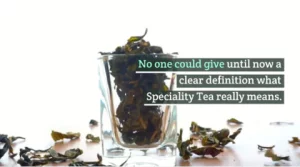If you are interested in tea, you may have heard the term “specialty tea” and may be wondering: what is it? Is it a new product? Is it a new tea?

No one has yet been able to give a clear definition of what specialty tea really means. One thing is clear, however: this is not a new product, but rather an increased awareness and new approach to tea and its production.
No new tea variety has appeared on the horizon. Tea, a product made from the Camellia Sinensis plant, still consists of only six different categories: White, green, yellow, oolong, black and dark tea.
What is changing is the attention paid to tea. Some even call it a kind of movement, perhaps comparable to the 3rd wave coffee movement of recent years. It focuses more on natural production with the aim of getting the best from the plant into our cups.
The tea industry of the last few centuries was characterized by mass production and automation. From harvesting to the various processing steps, the process has been automated as much as possible in order to obtain an affordable drink with a certain uniformity of taste. One cup fits all, ideally in a tea bag.
What we are seeing now is the partial reversal of this trend. We are focusing more and more on the differences in this natural product depending on the region where the plant is grown, the soil and climate, the cultivation and picking methods, the way the leaves are processed and, of course, how the tea is brewed.
